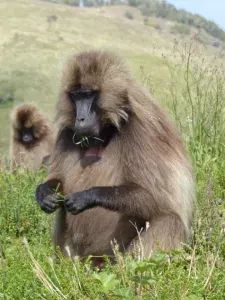
Most species of African baboon are not at all fussy what they eat and will just about eat anything — insects, lizards, roots and fruit. Some will even hunt, and eat baby antelope, but one species — which was once considered a true baboon, but now is found in its own genus, is a vegetarian: The Gelada monkey, found in the Ethiopian Highlands.
Female baboons, like all female monkeys and apes, have a regular breeding cycle. When she enters her breeding time/oestrus, she shows it really well — her bottom swells — this is a great sign to the males — one that they cannot miss!
What is interesting to note is that if she is not able to fall pregnant, in her next cycle her bottom will even grow bigger. In the wild, the males show the female attention and it is unlikely they will not mate with her.
However, this often does not happen in captivity, and the female baboons cannot breed as they should, so the poor things, when in oestrus, have to walk around with huge red/pink bottoms.
Young African baboon are usually carried under the belly by their mothers due to various safety measures and it’s also very easy for mothers to tend their young ones on this positions. Older babies are carried on the back.
5 different types of African baboons
As some of us know, there are 5 different types of baboons in Africa. The first one is the most unusual of all five and has a different social system compared to the other baboon species, it is also the northernmost of the baboons. This interesting and complicated baboon is the Hamadryus baboon.
It is native to the semi-desert regions of the Horn of Africa; also a corner of the Arabian Peninsular in Yemen and also found in the southwest of Saudi Arabia.
Their basic grouping is called a ‘harem’, which consists of one male leader, females and their young and one or two males called ‘followers’. One harem may join one or two other harems and form a band of Hamadryus baboons. This happens during the day, and at night the band of about 400 individuals, then usually join up with other bands to form a troop of about 1, 000 baboons, for protection purposes and warmth.
You may think this is chaotic, but each male leader controls his harem, and if any stray too far he herds them back, and also if they mistakenly socialise with the ‘outsiders’. A savage bite, by the leader, is sometimes delivered to steer them back to where they belong.
This complex social structure can continue for a number of years, and like the Mandrill monkey (not a baboon, but a monkey) the leader ‘steps down’ without fighting and allows another male to take his place.

